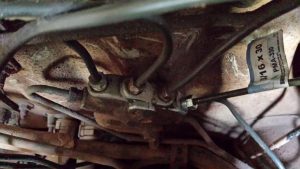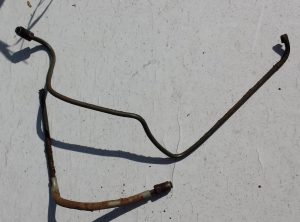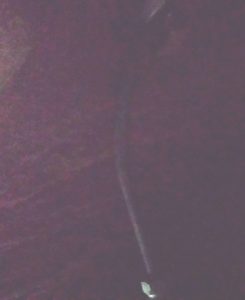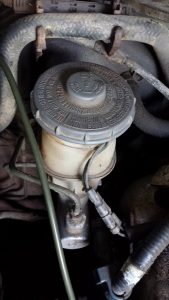I was in rush hour traffic outside Lévis, Quebec recently when the driver in front of me slammed on his or her brakes. I knew I had a weak brake line but I found out exactly how corroded it was when I pressed my brake pedal, the car slowed, and then the pedal dropped to the floor and I knew my brakes were gone.
I was saved by a few things. I never tailgate, and I always drive slower than the drivers around me. My lack of trust for the behaviour of those in front of me was more than helpful this time, and I was able to cut the wheel to the right and steer onto the breakdown lane long before I would have impacted the car in front of me.
Once I was in the breakdown lane and driving slowly in third gear with my hazard lights on, I’m sure more than a few of those caught in traffic beside me watched me pass with envy. They no doubt thought I was cheating the system, and using the breakdown lane to my advantage. I was ready for a cop to question me though, for I would merely point out that I had no brakes at all apart from the emergency brake.
Once I was leaving on the first off-ramp, I watched the light at the end of the lane warily. When it suddenly changed colour, I pulled up the emergency brake and the rear tires squealed me to a stop. The woman behind me honked and then gestured that I had accidentally left my emergency lights flashing and I waved to acknowledge that I was aware. Directly across from the intersection was a parking lot for a local pub, so I pulled into an empty part of the parking lot and pulled up the hood. At first the telltale oily mixture that is brake fluid was invisible to me in the undercoated engine compartment, but I knew only one brake line could be responsible. All of the other metal lines had been replaced; it could have been a flex hose to the individual wheels that went, but they rupture more rarely than the main lines, at least in my experience.
Once I found it was the brake line I suspected, I cut it in two with my wire cutters—I carry a full toolkit in the car as well as brake fluid—and then disconnected it from the juncture which is fed by the main brake cylinder. Then I used my pipe wrench in lieu of a hammer and bent the line back on itself and hammered it shut. After binding it with
in the car as well as brake fluid—and then disconnected it from the juncture which is fed by the main brake cylinder. Then I used my pipe wrench in lieu of a hammer and bent the line back on itself and hammered it shut. After binding it with  electrical tape, just in case the thousands of pounds per square inch pressure on the line caused it to expand, I reinstalled the short bend line on the juncture. That means the system as a whole is sealed again, and that I have enough braking power to at least search Lévis for a brake line.
electrical tape, just in case the thousands of pounds per square inch pressure on the line caused it to expand, I reinstalled the short bend line on the juncture. That means the system as a whole is sealed again, and that I have enough braking power to at least search Lévis for a brake line.
Tentatively, I pulled out of the parking lot and went toward a major stretch of busy road indicated a more industrial section of the town. In the heavy traffic I was happy to have even three brakes, and when I pushed the brake and pulled naturally enough to the right—given that only one front brake was working—I was able to compensate by turning the wheel. I found a NAPA store but once I pulled in and exercised my poor French, I found they didn’t have a line in stock. They would be able to get it to me by the morning, they explained, but I merely asked about a Canadian tire store. Their forty dollar and a day late brake line wasn’t that inviting anyway. I followed their directions, but soon realized I had lost something in the translation.
At a gas station I had better luck, and my French was slightly more honed, to the topic at least, and before long I was in the parking lot of the Canadian Tire store. I tried French, which deteriorates very quickly to Spanish in my case, that being my stronger language, but the man in automotive parts merely asked, “Do you speak English?” Sheepishly, I continued in English, bought a thirty inch line  that compared in terms of thread with the line I had brought into the store with me. This is done by pushing the threads together and looking for gaps when you hold them up to the light. Short of threading them into a hole, this is a way to ascertain that you are buying the right part. I supplemented that with a litre of brake fluid, and soon I was jacking up the front tire and removing it.
that compared in terms of thread with the line I had brought into the store with me. This is done by pushing the threads together and looking for gaps when you hold them up to the light. Short of threading them into a hole, this is a way to ascertain that you are buying the right part. I supplemented that with a litre of brake fluid, and soon I was jacking up the front tire and removing it.
I had parked away from the main lot when I’d come in, for this very reason, for it is not strictly acceptable to work on your car in the parking lot, although it is common. I’d also parked under a tree in order to take advantage of the shade on a hot day. Once I had the tire off, and I’d cleaned and then removed the brake line from the coupling to the flex hose behind the tire, ensured the bleed valve was not rusted shut by loosening it, I bent the new line to thread it into the coupling. I wanted to loosen the part in the juncture as late as possible in the procedure so I wouldn’t bleed out too much fluid.
ensured the bleed valve was not rusted shut by loosening it, I bent the new line to thread it into the coupling. I wanted to loosen the part in the juncture as late as possible in the procedure so I wouldn’t bleed out too much fluid.
Threading a line is an art as well as a science. The line has to be bent so it does not make the bolt cross-thread, and that often means trying it over and over and bending it slightly while doing so. When it was installed, I bent it into the configuration  it will need to go in to work around the master cylinder, and installed it as well. Then I refilled the flagging master cylinder with the brake fluid I still had—it turned out I had enough for the job after all—and then loosened the bleed valve.
it will need to go in to work around the master cylinder, and installed it as well. Then I refilled the flagging master cylinder with the brake fluid I still had—it turned out I had enough for the job after all—and then loosened the bleed valve.
The main problem with bleeding brakes is sucking air back into the bleed valve even as you get rid of air in the line. One way to do this is to keep replenishing the master cylinder and let the fluid gravity-feed through all the lines on its way to the bleed valves. I didn’t have time or inclination, so I pulled a hose from my windshield washer pump—which is conveniently located under the hood—hooked that up to the bleed valve and placed the other end in a cut off plastic water bottle. Then I pumped the brakes slowly, the fluid filled the translucent hose and its end sealed against reintroducing air by flooding the bottom of the bottle. Once there was two centimetres of fluid in the bottle, I tightened the bleed valve, put the hose back in the windshield washer system, put the tire back on, and sent a message to my friend in Montreal that I would be two hours late.
The entire fix took around two hours from the time my brakes went on the highway to being on the highway again. Most of that time was faffing about, although when I fixed the brakes I worked slowly and deliberately so that I would not make a mistake or break something else I would have to fix. Fixing a car beside the road often means you are rushed, and that is a bad headspace for a system as essential as brakes. The job took about a half hour, and I was back on the highway before I thought about how that experience would be entirely different depending on who was in my position. Many people would have had to wait until a garage could fix their car, and wait on getting parts from a dealer. While they were waiting, the mechanics would sense their desperation and find other parts that “must” be replaced immediately.
With some tools in the car, some knowledge of basic auto systems, and the willingness to try to fix it, a days-long ordeal can merely be a bump in an otherwise smooth road.
